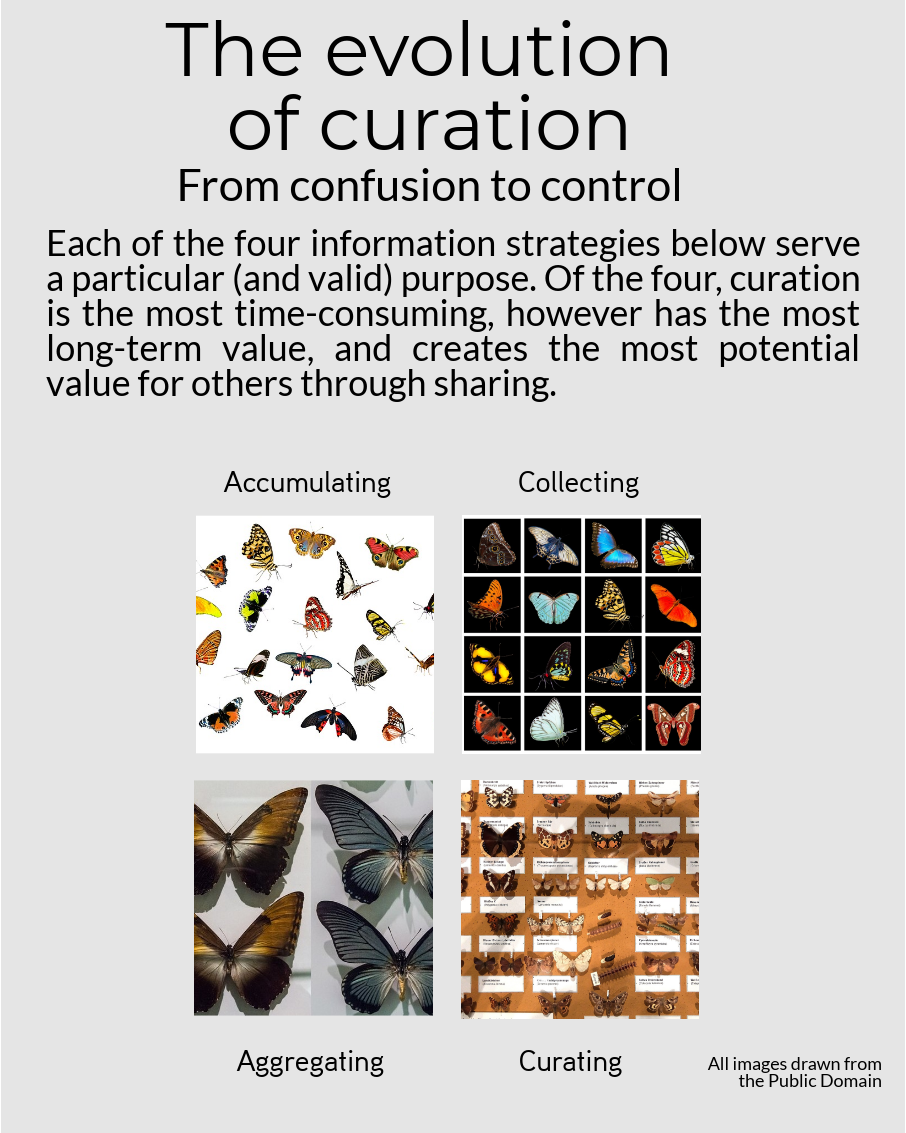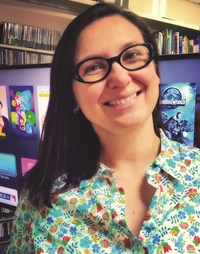Issue 105
Term 2 2018
Supercharge students' digital literacy skills with content curation
Kay Oddone discusses digital content curation as a secret weapon that can be used by teacher librarians to enrich their students’ digital literacy skills.
Digital content curation is a meta-skill, requiring many different facets of information and digital literacy. While articles abound promoting it as a tool for teachers, the rich learning opportunities embedded within this practice also make it a supercharged pedagogical approach for students. As the internet has transformed from the static Web 1.0 to the social and participatory Web 2.0, it is important that we offer students opportunities to remix and recreate content in new ways to enrich their research capabilities and enhance their digital literacy skills, and empower students to take an active role in information-rich contexts. Teacher librarians are perfectly positioned to assist with this process.
What is digital content curation?
Beth Kanter (2011) describes digital content curation as ‘helping your audience dive in and make sense of a specific topic, issue, event or news story. It is about collecting, but it is also about explaining, illustrating, bringing in different points of view and updating the view as it changes’.
This pithy summary captures the storytelling nature of digital content curation. Beyond simply saving a list of links, it is an active literacy practice that requires the curator to critically engage with information to construct a collection that meets a particular purpose (Mihailidis, 2015). Figure 1: The evolution of curation shows how managing links can develop from low-level accumulating to collecting, aggregating and on to curating.
Each of the information strategies described in the figure serve a particular and valid purpose. Curating is the most time-consuming, but has the greatest long-term value, and also creates the maximum potential for others through sharing.

Figure 1 The evolution of curation (Source: Kay Oddone)
While simple collecting is additive, curation is subtractive — what is left out is almost more important than what is included. A great way to think about collection and curation is described by Frank Chimero (2011). Consider collection as a bowl of loose pearls, and curation as a pearl necklace. The individual pearls in the bowl may be of great value, but they are pretty useless when they are just gathered together. Curation is what happens when particular pearls are selected from the bowl and strung, in a particular order, into a beautiful necklace. The necklace has fewer pearls than the bowl but, as it can be publicly admired and worn, it may be considered to have more worth.
An information and digital literacy meta-skill
Challenging students to create a high-quality curated collection assumes that they possess a wide range of information and digital literacy skills. Adopting the curation approach outlined by Weisgerber (2011), students must find, select, editorialise, create and share their collection.
These steps encourage students to develop and apply many different information and digital literacy strategies. Breaking down each of these steps makes it possible to identify just what these strategies are and demonstrates the rich teaching opportunities embedded in them.
Finding the information
Creating a curated collection of high-quality information requires more than a simple Google search. This first step in the curation process requires students to develop their expert search skills, so that they go beyond the first hits returned by the search engine to find relevant information that warrants inclusion in their collection.
Expert search strategies, including the use of keywords, advanced search operators and Boolean logic, are key tools in the curator’s arsenal. Another strategy that students may rarely consider is to be found in social media. Searching Twitter, Instagram and Facebook using the hashtag symbol (#) appended to keywords can be surprisingly effective in locating quality information and resources, particularly in rapidly changing or developing areas, including current affairs.
Selecting what to include
Through the process of content curation, students must apply several different evaluative approaches to select resources and information that is of the highest quality and most aligned to their purpose and audience. Critical evaluation is a key skill that every student must develop in our environment of information abundance. This is an ongoing process for all of us, particularly as online publishing makes it increasingly difficult to identify credible information from that which is of dubious quality.
Evaluating material for selection and inclusion in a curated collection requires students to apply several critical lenses. At a surface level, they should use a framework such as the CRAP test, attributed to Beestrum & Orenic (2008), which prompts examination for currency, reliability, authority and purpose. Depending on the topic being researched, students should also be introduced to the potential for satire, clickbait, highly biased or just plain fake information masquerading as high-quality information. Interrogating information by asking questions such as ‘Whose voices are heard, and whose are silenced?’ and ‘Who may benefit from this?’ also provides a deeper level of analysis, which Lupton (2016) describes as transformative.
Editorialising or annotating the collection
Adding an editorial note or annotation to each inclusion within the curated collection is a key step that is often overlooked. Although time-consuming, these short passages add real value and help to differentiate a curated collection from an aggregated list. Ideally, the annotation should explain why the piece was chosen and how it fits within the collection. This makes the individual items more meaningful and brings the collection together as a whole resource.
Requiring editorials for each curated item enables students to demonstrate higher level thinking skills as they must summarise each article, identify how it contributes to the collection, and, if possible, draw links between it and other items within the group. Students are therefore practising how to evaluate, analyse and synthesise each item and, in doing so, creating a unique digital artefact that positively contributes to their digital footprint.
Creating and publishing the collection
There are many online tools that exist for the creation of digital curated collections. Deciding which to choose requires an awareness of audience, the capabilities of each tool for presentation, and a knowledge of digital publication strategies. Students may be drawn to applications such as Pinterest for highly visual topics, Diigo for text-heavy, complex collections, or Scoop-it for extensive annotation capacity. Choice of tool also depends on the age of the student (some tools require account holders to be 13 years or older) and the likely users of the collection. Some tools require an account to view curated collections, while others are published openly.

Republishing content through digital content curation requires a knowledge of copyright. Although the copyright implications remain a grey area, it is important that students model best practice, curating directly from the original publisher or owner of the content, rather than from second- or third-hand sources. It is also important for students to be aware that the usual educational exemptions do not apply when sharing on the open web.
Sharing the collection
The value of a digital curated collection is lost if it is not shared. Students may be encouraged to include their curated collection on library web pages for other students to make use of, or may include it as part of a larger digital project such as a blog or website. They can also seek feedback on their collection by emailing or communicating the link via social networks.
Understanding how a digital curated collection may be shared provides new learning opportunities as we encourage students to actively and positively develop their online presence for future purposes. Students can also add the web links of their curations into their digital portfolio to show evidence of their learning.
A supercharged pedagogical approach
Digital content curation is a meta-skill, and it is evident that it includes an array of information and digital literacy skills. The process of digital content curation offers many learning opportunities that are ideally taught by the teacher librarian or teacher within the context of a larger research project. Spread over a term or semester, students could curate and publish resources relevant to their chosen topic. This in itself could be an assessment task. The curated collections could be used as a basis for a research project or, even better, could be shared and used to inform future students’ study.
Championing digital content curation for learning
Teacher librarians are perfectly positioned to work with teachers and students to enhance the information and digital literacy skills that underpin digital content curation. It is not only an information management strategy, but also a powerful pedagogical practice that may be built into any curriculum area. Digital content curation is a strategy that we will all make increasing use of in an information-saturated society, and explicitly teaching the process is an innovative and creative way to encourage students to become active and critical users of information.
To support this article, I have curated a Padlet that provides further reading and resources to extend the concepts introduced here.
References
Beestrum, M & Orenic, K 2008, The CRAP test, http://loex2008collaborate.pbworks.com/w/page/18686701/The%20CRAP%20Test
Chimero, F 2011, Sorting a mass, blog post (archived), https://archive.li/LQovs
Kanter, B 2011, Content curation primer, blog post, http://www.bethkanter.org/content-curation-101/
Lupton, M 2016, Critical evaluation of information — transformative window, blog post, https://inquirylearningblog.wordpress.com/2016/07/22/critical-evaluation-of-information-transformative-window/
Mihailidis, P 2015, 'Digital curation and digital literacy: evaluating the role of curation in developing critical literacies for participation in digital culture', E-learning and digital media, 12 (5–6), 443–458, doi: 10.1177/2042753016631868
Weisgerber, C (Producer) 2011, Building thought leadership through content curation, slide presentation, https://www.slideshare.net/corinnew/building-thought-leadership-through-content-curation
